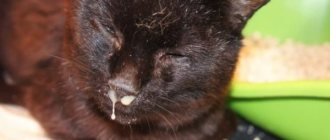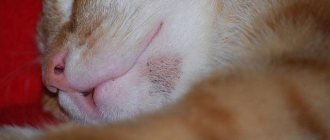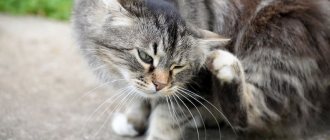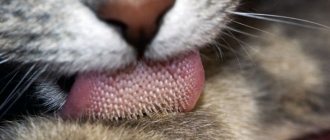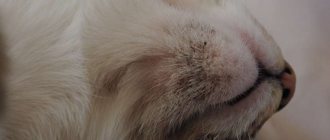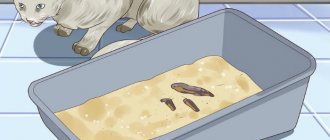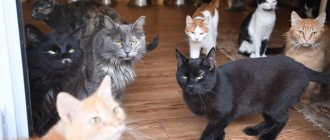Possible diseases
Quite often, cats have black spots in and around the mouth. Often their appearance is associated with a genetic predisposition and does not cause any inconvenience to the pet. But in some cases, these spots indicate an incipient pathology. Therefore, if you find dark spots on your cat’s tongue, you need to visit a veterinarian.
Lentigo
Lentigo is a genetic disorder in cats that results in dark, freckle-like spots. Lentigo can appear on the lips, gums, and tongue. As they spread, the spots may also appear around the edges of the cat's eyes or on the eyelids. Lentigines can sometimes be found in the ears and even on the pads of the feet.
Lentigo can appear in cats of red, tortoiseshell, peach, sandy and red colors. Freckles are the result of pigment-producing cells called melanocytes, which have more melanin than the surrounding skin. No one knows why some cats have a genetic predisposition to lentigo.
Lentigo
The most common cause of black spots in a cat's mouth is increased pigment formation. Sometimes kittens are born with small spots, which become more noticeable as they grow older. These dark marks are called lentigines and their appearance is not dangerous for furry pets. However, stains with this defect should not:
- itch;
- protrude above the surface of the skin and mucous membranes;
- have a rough surface;
- peel off.
Most often, lentigo occurs in red or tortoiseshell cats.
Preventing HPV infection
Condylomas must be prevented by preventive measures:
- use of contraceptives during sexual relations;
- increasing immunity;
- proper balanced nutrition;
- taking vitamins;
- compliance with hygiene standards;
- fight against bad habits;
- increasing stress resistance.
Regular visits to the doctor are a good preventative measure. The use of antiviral ointments, as well as vaccination against HPV, is prevention that will make people’s lives full.
Avitaminosis
Black spots on the tongue can occur due to a lack of vitamin B2.
This is caused by an unbalanced diet or consumption of economy-class feed. If your cat has dark spots in its mouth, sleeps a lot, eats poorly and loses a lot of fur, you can introduce the following into its diet:
- sprouted grains of buckwheat, corn and peas;
- wheat germ;
- unboiled cow's milk;
- egg white;
- dandelion leaves;
- dry brewer's yeast.
When feeding commercial food, it may be necessary to additionally introduce complex supplements of B vitamins, but this can only be done with the permission of a veterinarian.
Many people believe that only aggressive cats have black spots in their mouths. But observations of them prove that the character of the animal does not depend on the dark coating. Spots can appear even in calm, affectionate animals, and only the attentiveness of the owner will help to detect dangerous diseases in time.
Source
Treatment
The treatment your veterinarian prescribes depends on the cause of the dark spots and spots. For example, acne is a consequence of liver dysfunction, especially in old animals. Treatment in this case includes changing the diet in such a way as to minimize the load on this organ.
It is important to prevent stress; cats should be comfortable in the house. Bowls and tray must be clean. It is better to replace plastic bowls for food and water with glass or stainless steel bowls to avoid allergic reactions.
It is best to use glass dishes and stainless steel bowls when feeding cats.
It is necessary to use vitamin supplements for cats aimed at normalizing the functioning of the immune system. To rule out food allergies, you can switch your cat to diet food and medicated food.
Infectious diseases in cats are quite easy to identify, since this will affect the behavior of the pet. Infections weaken the body, the animal becomes apathetic, lethargic, refuses to eat and sleeps a lot. But the occurrence of infections can also be determined by black spots on the tongue, lips, and around the mouth.
For predators, the condition of teeth and gums is of particular importance. The easiest way to prevent serious oral diseases is to have your teeth cleaned regularly by a veterinarian. The doctor will help not only remove plaque from the cat’s teeth, but also get rid of tartar. It will also apply a special solution to strengthen and prevent re-formation of the stone.
Only a veterinarian can make a correct diagnosis after examination.
Possible toxoplasmosis
Toxoplasmosis is an infection caused by a parasite and is also sometimes the cause of a black tongue. Toxoplasmosis can be contracted from contaminated food, but it can also be spread from animal to animal or person through contaminated feces. Do not feed your pet raw meat. Clean your cat's litter box every day and wear gloves when doing so. Don't let him defecate in your garden, as this could contaminate your vegetables.
Source
Associated signs of disease and treatment
Dark spots
In this condition, the animal spends a lot of time sleeping.
Pellagra, or simply hypovitaminosis, affects cats very rarely. Poor or unbalanced nutrition leads to problems in the animal's body. Drowsiness, apathy, as well as the presence of dark spots on the tongue are reasons to contact a veterinary clinic. If the diagnosis is correct, then treatment will be focused on replenishing the pet’s nicotinic acid. Depending on the way you eat, you need to add to your diet:
- vitamin supplements for cats;
- kidneys, liver and fish;
- dairy products and carrots.
Lentigo is a hereditary disease characterized by a brown spot in adult animals. In cats, this condition is quite rare; spots are formed due to an increase in the number of melanocytes on the surface of the skin. Often, a smooth brown rash with a diameter of up to 10 mm is located on the mucous membrane of the mouth and can cover the palate, nose, eyelids and ears. Formation begins in kittens before 12 months and localization expands with age. The disease has no symptoms and does not require treatment.
Return to contents
Black dots
Owners often find such skin rashes on their pets.
Acne is a dark rash on the skin in the form of blackheads. Having tried to erase blackheads and failed, the owner is convinced that the cat has acne. Concomitant signs of skin diseases may include swelling, baldness and redness of the skin, and the number and volume of acne increases. The pet's behavior is restless and it scratches the itchy area. Since the disease is a concern, you should consult a veterinarian and undergo an examination. In animals, as in people, acne on the skin can be a consequence of blockage of the sebaceous glands, and then treatment can be carried out with folk remedies, rubbing the sore spot with herbal infusions.
Melanoma is the presence of malignant tumors in the body. The appearance of black spots or spots on the gums in an elderly pet, as well as apathy and loss of appetite should alert the owner. Since the presence of a tumor can only be determined by a doctor, and treatment requires surgery, you should urgently contact a veterinary clinic for examination.
If there is a putrid smell from the mouth, then the cat may have a serious disease of the teeth or gums.
Return to contents
Papillomavirus
In kittens under six months of age, dark spots are often found on the tongue and inside of the cheeks, similar to voluminous birthmarks with a flat top. They are called oral papillomas or warts. Such stains should be removed as they can rub and cause pain when fed.
Since these warts can easily be confused with a cancerous tumor, diagnosis and treatment are carried out only under the supervision of a veterinarian. Most often, a course of antiviral drugs, such as interferon, is prescribed. You can also give your pet a special vaccine, with which it will develop lasting immunity to the papilloma virus for a long time. More expensive but effective ways to treat warts are cryotherapy and laser therapy.
The tongue turned black. What to do?
What to do if your tongue turns black, and which doctor should you go to? It must be remembered that a dark coating on the tongue is just a symptom of the underlying disease. To eliminate it, it is necessary to cure the disease itself. First of all, seek help from your dentist. The dentist must rule out dental problems and fungal infection. To treat fungus, your doctor may use topical medications. It is necessary to carry out dental treatment and remove tartar. Toxins produced by microbes that live in cavities and tartar can cause the tongue to turn black.
Oral hygiene rules during treatment
Basic rules for oral care:
- Brush your teeth and tongue 2 times a day
- Use a tongue scraper (removes plaque better)
- Use rinse aids
Causes of pathology
The infection is caused by group A streptococcus. A person can be either a carrier of the pathogen or an active source of infection. The greatest contagiousness is observed in the first 1-4 days of the acute period. 3 weeks after the onset of the disease, the likelihood of the infection spreading is reduced to zero. Up to 20% of the adult population are asymptomatic carriers of streptococcus. There is a seasonal dependence: the largest number of infections is recorded in the autumn-winter period against the background of acute respiratory viral infections, tonsillitis, and pneumonia.
Coated tongue
Quite often, black spots on a cat’s tongue go away after eating or drinking water. In this case, we are talking about the usual plaque that appears when eating dark-colored food. Often, a coating on the tongue is discovered after the cat plays with some objects painted in a dark color. Dots on the tongue may remain if the animal has chewed plastic or painted wood. Particles of dye get clogged between the papillae on the tongue and the appearance of dark dots and spots is created.
Why do they appear?
In a cat, black spots and dots in the mouth arise due to the maximum activity of the cells that are responsible for the release of pigment. Cats are prone to pigmentation, especially red cats. A kitten may be born with black dots and spots on the tongue and palate, and then pigmentation appears on the lip, nose or in the mouth, but this is not dangerous. A genetic predisposition to staining with spots may cause them to appear. If a cat develops black spots at an older age, especially an older one, this requires consultation with a veterinarian. There are a number of factors influencing the appearance of blackheads in the mouth, namely:
- hormonal imbalance;
- poor nutrition;
- problems of the gastrointestinal tract and central nervous system;
- poor immunity.
Sometimes dark spots in the mouth disappear after eating. In such cases, you need to monitor your pet. Cats' tongues are covered with hardened nipples that help them drink, hold food, and lick fur. Perhaps the animal is gnawing on some objects, and the remains get stuck on its tongue, causing it to turn black. When eating food, the cat swallows everything along with it. In this case, there is no reason to worry.
How to warn?
Cats are quite clean animals, so rashes on the lips, apart from hereditary ones, are quite rare. A poorly balanced diet and the inability of a cat to replenish its diet with the vitamins and minerals it needs leads to an imbalance of the entire body. The owner needs to monitor the animal’s food and wash the food bowl on time, since bacteria multiply well in dirty dishes, which can get into the mouth while eating. Air pollution and frequent psychological stress from aggressive behavior with the pet by its owner can also cause the appearance of spots and spots. Only the care and quick reaction of the owner to any changes in the behavior or appearance of the pet will give it a long and happy life.
Source
